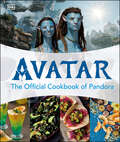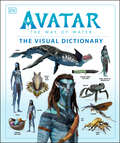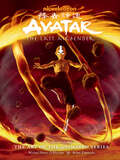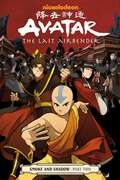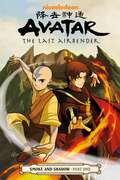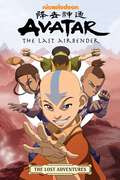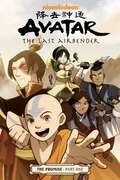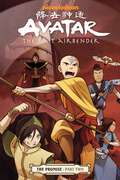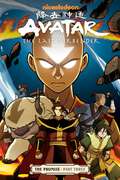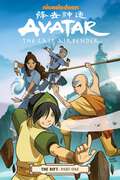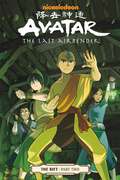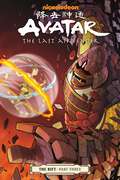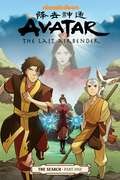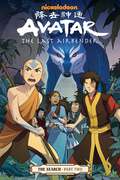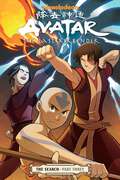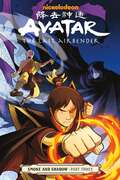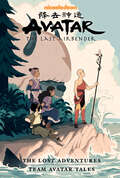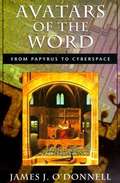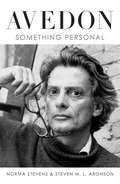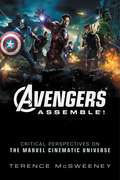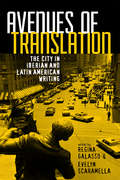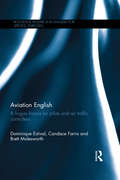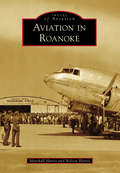- Table View
- List View
Avatar The Official Cookbook of Pandora
by DKBe transported to the breathtaking locations of Avatar and Avatar: The Way of Water with more than 50 delicious recipes inspired by the lush biomes of Pandora.Experience the Hallelujah Mountains&‘ High Camp, the secret cave encampment of the Omatikaya, the reef atolls of the Metkayina clan and sacred sites such as the Tree of Souls in a new, mouthwatering way through carefully curated recipes inspired by the peaceful Na&’vi lifestyle. Feast on everything from Pandoran pancakes and Sully family shakshuka, to delicious frittatas, fish dishes, soups, salads, and stews, topped off with Na&’vi deserts, sunrise cocktails, and frozen mocktails.This official cookbook conjures the magical landscapes, flora, fauna, and atmosphere of James Cameron&’s Avatar, all lavishly photographed for movie fans and foodies alike.
Avatar The Way of Water The Visual Dictionary
by Ben Procter Joshua Izzo Zachary Berger Dylan Cole Reymundo PerezDive into the depths of Avatar: The Way of Water with this definitive guide. Created in close collaboration with James Cameron&’s Lightstorm Entertainment and written by experts who worked on the film, this authoritative book is packed with stunning exclusive details. This must-have visual guide showcases the characters, creatures, vehicles, weapons, and locations from the latest adventure in Pandora. Meet the next generation of Jake Sully and Neytiri&’s family, including the mysterious Kiri and the heroic Neteyam, and their brave new allies among the Metkayina clan. Discover the majestic tulkun, speedy skimwings, and the other fauna and flora of Pandora&’s oceans. Examine the latest fearsome RDA vehicles and the specialist recom troops under Colonel Quaritch&’s command. Uncover the inner workings of Bridehead City and the sacred Cove of the Ancestors. With a foreword by Sigourney Weaver, Avatar: The Way of Water: The Visual Dictionary is the perfect gift for Avatar fans of all ages. © 2022 20th Century Studios.
Avatar: The Last Airbender The Art of the Animated Series (Second Edition)
by Michael Dante DiMartino Bryan KonietzkoThe animated series Avatar: The Last Airbender has inspired millions of fans and industry professionals alike. Now, to celebrate the anniversary of the show's first airing comes this deluxe second edition of Avatar: The Last Airbender--The Art of the Animated Series!Join series creators Bryan Konietzko and Michael Dante DiMartino for an unprecedented behind-the-scenes look at hundreds of pieces of concept, design, and production art from the show. You'll be taken on a guided tour through the development of this smash-hit television series in this deluxe edition that includes: • Stunning new cover art by Bryan Konietzko, with an extra special cover treatment! ! • Eight pages of new material, plus an all-new introduction by award-winning Avatar: The Last Airbender comics series writer Gene Luen Yang!
Avatar: The Last Airbender - Smoke and Shadow Part 2
by Gene Luen YangWith the disappearances of children in the Fire Nation capital, Avatar Aang and his friends are doing everything they can to find out who—or what—is responsible.Aang and Zuko must work together to keep the peace, but the emergence of the New Ozai Society, and the appearance of the mysterious Kemurikage of legend, may prove to be too much even for the Avatar when the true culprit of the kidnappings is revealed!* The official continuation of Airbender from its creators, Michael Dante DiMartino and Bryan Konietzko!* The perfect companion to The Legend of Korra!
Avatar: The Last Airbender - Smoke and Shadow Part One (Avatar: The Last Airbender)
by Gene Luen YangThe Fire Nation is threatened by a prophecy told by the Kemurikage--mysterious figures thought only to exist in legend--remove Zuko from the throne or the country will perish!Avatar Aang and his friends escort Zuko and his family back to the capitol completely unaware of the looming threat growing in the city. Unrest is brewing as the New Ozai Society prepares to make its move against the crown, and children begin to go missing from their homes under mysterious circumstances! Written and drawn by the creative team behind the best-selling The Promise, The Search and The Rift, Gene Luen Yang and Gurihiru, in collaboration with Avatar: The Last Airbender and Legend of Korra creators Michael Dante DiMartino and Bryan Konietzko, this is the ultimate continuation of Avatar and the perfect companion to Legend of Korra!
Avatar: The Last Airbender - The Lost Adventures (Avatar: The Last Airbender)
by VariousFor three years, millions of eager fans tuned in to watch new episodes of Nickelodeon's hit animated series Avatar: The Last Airbender. Ever since, fans have been hungry for more—and now their wait is finally over!This volume collects the long-out-of-print, fan-favorite comics previously published in Nickelodeon Magazine and with the Airbender DVDs, plus over seventy brand-new comics pages. That's twenty-six stories set in Airbender continuity, by a host of top-notch talent, many of whom worked on the original animated series!* A must-have for any Airbender fan!* Twenty-six in-continuity stories, plus bonus content!* The latest release in an ongoing partnership between Nickelodeon and Dark Horse, to bring you the very best in Airbender books!
Avatar: The Last Airbender - The Promise Part 1 (Avatar: The Last Airbender)
by Gene Luen YangThe wait is over! Ever since the conclusion of Avatar: The Last Airbender, its millions of fans have been hungry for more—and it's finally here!This series of digests rejoins Aang and friends for exciting new adventures, beginning with a faceoff against the Fire Nation that threatens to throw the world into another war, testing all of Aang's powers and ingenuity!* The continuation of Airbender and the link to its upcoming sequel, Legend of Korra!* Written by Gene Luen Yang, author of the National Book Award-nominated American Born Chinese.
Avatar: The Last Airbender - The Promise Part 2 (Avatar: The Last Airbender)
by Gene Luen YangAang and Katara are working tirelessly for peace when an impasse between Fire Lord Zuko and Earth King Kuei over Fire Nation colonies within the borders of the Earth Nation threatens to plunge the world back into war! Meanwhile, Sokka must help Toph prepare her hapless first class of metalbending students to defend their school against a rival class of firebenders! * Written by Eisner winner and National Book Award nominee Gene Luen Yang (American Born Chinese).
Avatar: The Last Airbender - The Promise Part 3 (Avatar: The Last Airbender)
by Gene Luen YangAvatar: The Last Airbender creators Michael Dante DiMartino and Bryan Konietzko bring The Promise to its explosive conclusion! The Harmony Restoration Movement has failed, and the four nations are plunged back into war! In the midst of the battle, can Aang and Fire Lord Zuko mend the rift between them, or will Aang be forced to take actions that can't be undone? Written by Eisner winner and National Book Award nominee Gene Luen Yang (American Born Chinese) and drawn by Gurihiru(Thor and the Warriors Four), this is the adventure Avatar fans have been craving!
Avatar: The Last Airbender - The Rift Part 1 (Avatar: The Last Airbender)
by Gene Luen YangAvatar Aang asks his friends to help him honor Yangchen's Festival—one of the highest Air Nomad holidays, which hasn't been celebrated in over one hundred years. But cryptic visits from the spirit of Avatar Yangchen herself lead Aang to discover a jointly owned Fire Nation and Earth Kingdom refinery—operating on land sacred to the Airbenders! Is this the cause of the pollution Aang finds there, or is a more mysterious menace afoot? * The official continuation of Airbender from the original series creators! * Continues to top the sales charts! * The perfect companion to The Legend of Korra! "One of the best new pop culture mythologies to debut in the last decade."—Kotaku "A fantastic glimpse into the post-series universe."—Bleeding Cool
Avatar: The Last Airbender - The Rift Part 2 (Avatar: The Last Airbender)
by Gene Luen Yang Michael Dante DiMartinoTeam Avatar find themselves up to their necks in trouble as mysterious forces threaten to destroy land once sacred to the Airbenders! While Aang journeys to the spirit world in search of clues, Toph faces off against her own past!* The official continuation of Airbender from its creators, Michael Dante DiMartino and Bryan Konietzko!* Avatar: The Last Airbender—The Search continues to top the sales charts!* The perfect companion to The Legend of Korra!
Avatar: The Last Airbender - The Rift Part 3 (Avatar: The Last Airbender)
by Gene Luen YangWritten and drawn by the creative team behind the best-sellingThe Promise and The Search, in collaboration with the creators ofAvatar: The Last Airbender and The Legend of Korra, this is the ultimate continuation of Avatar and the perfect companion toKorra!* The official continuation of Airbender from its creators!&“As with much of what the show and comic series have done, it&’s nothing like what I expected, and is still so satisfying.&”—Fandom Post
Avatar: The Last Airbender - The Search Part 1 (Avatar: The Last Airbender)
by Gene Luen YangFor years, fans of Avatar: The Last Airbender and The Legend of Korra have burned with one question—what happened to Fire Lord Zuko's mother? Finding a clue at last, Zuko enlists the aid of Team Avatar—and the most unlikely ally of all—to help uncover the biggest secret of his life. * This is the perfect companion to The Legend of Korra! * The official continuation of Airbender from its creators!
Avatar: The Last Airbender - The Search Part 2 (Avatar: The Last Airbender)
by Gene Luen YangIn search of their long-lost mother, Fire Lord Zuko and his deadly and insane sister Azula have brought Avatar Aang and his friends into a mysterious forest, but what they discover within may be more than they can face. Will they too be lost in these woods forever? * Perfect companion to Legend of Korra! * The official continuation of Airbender from its creators. "A fantastic glimpse into the post-series universe... " —Bleeding Cool
Avatar: The Last Airbender - The Search Part 3 (Avatar: The Last Airbender)
by Gene Luen YangAvatar Aang travels to the spirit world to parley with an ancient power; bringing Fire Lord Zuko ever closer to discovering the truth about his mother's fate—and his own past. Yet Zuko's sister Azula is becoming increasingly dangerous; threatening to ruin everything that Zuko; Aang; Katara; and Sokka have struggled to achieve on their search! * The official continuation of Airbender from its creators; Michael Dante DiMartino and Bryan Konietzko!
Avatar: The Last Airbender- Smoke and Shadow Part Three
by Gene Luen YangChildren are disappearing in the Fire Nation capital! Avatar Aang and his friends are doing everything in their power to save them—but will it be enough?And worse, when Azula—the mad sister of Fire Lord Zuko—appears on the scene, Zuko locks down the city to catch her, igniting fear and riots in the streets! Will Zuko follow in his evil father&’s footsteps in order to save those he holds dear?* The official continuation of Airbender from its creators, Michael Dante DiMartino and Bryan Konietzko!
Avatar: The Last Airbender--North and South Part One (Avatar: The Last Airbender: North and South #1)
by VariousFrom National Ambassador for Young People&’s Literature, Eisner Award winner, and #1 New York Times bestseller Gene Yang!When Aang leaves to aid Zuko with the Kemurikage, Katara and Sokka return to the Southern Water Tribe by themselves. Katara is shocked to find that her beloved village has become a bustling city, with none other than their father, Hakoda, in charge! A northerner named Malina seems to be behind this change, pushing the North and South to be more unified . . . but what are her true goals?* The official continuation of Airbender from its creators, Michael Dante DiMartino and Bryan Konietzko!
Avatar: The Last Airbender--The Lost Adventures and Team Avatar Tales Library Edition
by Gene Luen Yang Faith Erin HicksThe comics continuation of Nickelodeon's hit series Avatar: The Last Airbender returns with a treasure trove of short stories, collected for the first time in hardcover!Follow Team Avatar as they journey through the four nations! From Earth King Kuei to the Kyoshi Warriors, and Mai to the Boulder, your favorite Avatar: The Last Airbender friends are back for a wide-ranging exploration of life in their world. And where they go, danger, fun, and hijinks are sure to follow! This full-color edition collects short stories from The Lost Adventures and Team Avatar Tales, and includes the work of fan-favorite creators like Michael Dante DiMartino, Gene Luen Yang, Gurihiru, Faith Erin Hicks, Kiku Hughes, and many more! Add this gorgeous collection to your bookshelf today!
Avatars of the Word: From Papyrus to Cyberspace
by James J. O'DonnellConsiders the future of the printed word given the growth of electronic communication as a modern medium for information and culture. In investigating past cultural transitions, such as from the spoken to the written word, or from manuscript to the printing press, O'Donnell (classical studies, U. of Pennsylvania) reveals the contemporary crossroads between media as contiguous with the history of communication. Annotation c. by Book News, Inc. , Portland, Or.
Avedon: Something Personal
by Steven M. Aronson Norma StevensAn intimate biography of Richard Avedon, the legendary fashion and portrait photographer who “helped define America’s image of style, beauty and culture” (The New York Times), by his longtime collaborator and business partner Norma Stevens and award-winning author Steven M. L. Aronson. Richard Avedon was arguably the world’s most famous photographer—as artistically influential as he was commercially successful. Over six richly productive decades, he created landmark advertising campaigns, iconic fashion photographs (as the star photographer for Harper’s Bazaar and then Vogue), groundbreaking books, and unforgettable portraits of everyone who was anyone. He also went on the road to find and photograph remarkable uncelebrated faces, with an eye toward constructing a grand composite picture of America. Avedon dazzled even his most dazzling subjects. He possessed a mystique so unique it was itself a kind of genius—everyone fell under his spell. But the Richard Avedon the world saw was perhaps his greatest creation: he relentlessly curated his reputation and controlled his image, managing to remain, for all his exposure, among the most private of celebrities. No one knew him better than did Norma Stevens, who for thirty years was his business partner and closest confidant. In Avedon: Something Personal—equal parts memoir, biography, and oral history, including an intimate portrait of the legendary Avedon studio—Stevens and co-author Steven M. L. Aronson masterfully trace Avedon’s life from his birth to his death, in 2004, at the age of eighty-one, while at work in Texas for The New Yorker (whose first-ever staff photographer he had become in 1992). The book contains startlingly candid reminiscences by Mike Nichols, Calvin Klein, Claude Picasso, Renata Adler, Brooke Shields, David Remnick, Naomi Campbell, Twyla Tharp, Jerry Hall, Mikhail Baryshnikov, Bruce Weber, Cindy Crawford, Donatella Versace, Jann Wenner, and Isabella Rossellini, among dozens of others. Avedon: Something Personal is the confiding, compelling full story of a man who for half a century was an enormous influence on both high and popular culture, on both fashion and art—to this day he remains the only artist to have had not one but two retrospectives at the Metropolitan Museum of Art during his lifetime. Not unlike Richard Avedon’s own defining portraits, the book delivers the person beneath the surface, with all his contradictions and complexities, and in all his touching humanity.
Avengers Assemble!: Critical Perspectives on the Marvel Cinematic Universe
by Terence McSweeneyWe are living in the age of the superhero and we cannot deny it. <P><P>Avengers Assemble! is a vibrant and theoretically informed interrogation of one of the defining and most financially successful film franchises of the new millennium. In the first single-authored monograph on the topic of the Marvel cinematic universe, Terence McSweeney asks, "Why has the superhero genre reemerged so emphatically in recent years?" In an age where people have stopped going to the cinema as frequently as they used to, they returned to it in droves for the superhero film. What is it about these films that has resonated with audiences all around the globe? Are they just disposable pop culture artifacts or might they have something interesting to say about the fears and anxieties of the world we live in today? <P><P>Beginning with Iron Man in 2008, this study provocatively explores both the cinematic and the televisual branches of the series across ten dynamic and original chapters from a diverse range of critical perspectives which analyse their status as an embodiment of the changing industrial practices of the blockbuster film and their symbolic potency as affective cultural artifacts that are profoundly immersed in the turbulent political climate of their era.
Avenues of Translation: The City in Iberian and Latin American Writing
by Ilan Stavans Peter Bush Christopher Maurer Hugh Hazelton Esther Allen Alicia Borinsky Evelyn Scaramella Charles Hatfield Jennifer Duprey Urayoán Noel Regina Galasso Suzanne Levine Nicholas GoodbodyCities both near and far communicate in a variety of ways. Travel between, through, and among urban centers initiates contact, and cities themselves are sites of ever-changing cultural and historical encounters. Predictable and surprising challenges and opportunities arise when city borders are crossed, voices meet, and artistic traditions find their counterparts. Using the Latin word for “translation,” translatio, or “to carry across,” as a point of departure, Avenues of Translation explores how translation perpetuates, diversifies, deepens, and expands the literary production of cities in their greater cultural context, and how translation shapes an understanding of and access to a city's past and present literary and cultural practices. Thinking about translation and the city is a way to tell the backstories of the cities, texts, and authors that are united by acts of translation. Published by Bucknell University Press. Distributed worldwide by Rutgers University Press.
Aviation English: A lingua franca for pilots and air traffic controllers (Routledge Research in English for Specific Purposes)
by Dominique Estival Candace Farris Brett MolesworthAviation English investigates the key issues related to the use of English for the purpose of communication in aviation and analyses the current research on language training, testing and assessment in the area of Aviation English. Based on a series of recent empirical studies in aviation communication and taking an interdisciplinary approach, this book: provides a description of Aviation English from a linguistic perspective lays the foundation for increased focus in the area of Aviation English and its assessment in the form of English Language Proficiency (ELP) tests critically assesses recent empirical research in the domain. This book makes an important contribution to the development of the field of Aviation English and will be of interest to researchers in the areas of applied linguistics, TESOL and English for Specific Purposes.
Aviation Firsts: 336 Questions and Answers (Dover Transportation)
by Joshua StoffCurious about the first person to be born in an airplane, which American president was the first to fly, or who built the world's first helicopter? Answers to these and other aviation-related questions can be found in this fascinating, fact-filled book compiled by Joshua Stoff, Air and Space Curator of the Cradle of Aviation Museum in Garden City, New York.You'll find the answers to questions about virtually all "firsts" in the history of flight, including these puzzlers: Who was the first licensed American woman pilot? Where was America's first airport? Which was the world's first aircraft manufacturing company? Who was the first person killed in a powered aircraft? When was a satellite first repaired in space? . . . and many moreBrimming with names, dates, and events that made aviation history, this handy reference will not only settle arguments between aviation buffs, but will also provide answers for journalists, students, and aerospace executives -- and fascinating browsing for the general reader.
Aviation in Roanoke (Images of Aviation)
by Nelson Harris Marshall HarrisIn 1910, an awestruck crowd at the Roanoke Fair got its first glimpse of powered flight when a Curtiss biplane soared overhead. Within the next decade, gliders were lifting off from hills in South Roanoke and cow pastures were being converted into airstrips. Once Roanoke Municipal Airport was developed in 1929, earlier local airfields such as Cook, Trout, and Horton Fields were rendered inactive. Then in 1941, when--with federal assistance-- the municipal airport became Woodrum Field, the region's air travel transitioned into the modern era and brought services from major airlines to the area. Roanoke's aviation reputation continued to grow when the city played a critical role in military air travel and training during World War II, leading its airport to become one of the busiest on the East Coast. Aviation in Roanoke tells the stories of early airfields, the growth and transformation of Woodrum Field, and the adventures of Roanoke's aviation pioneers.
